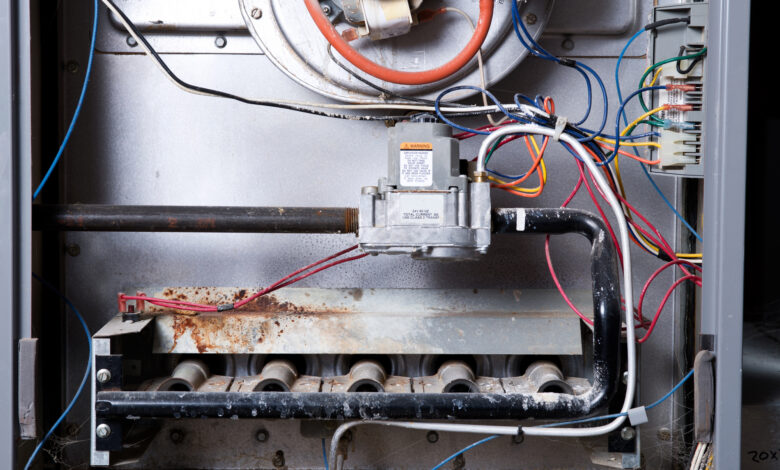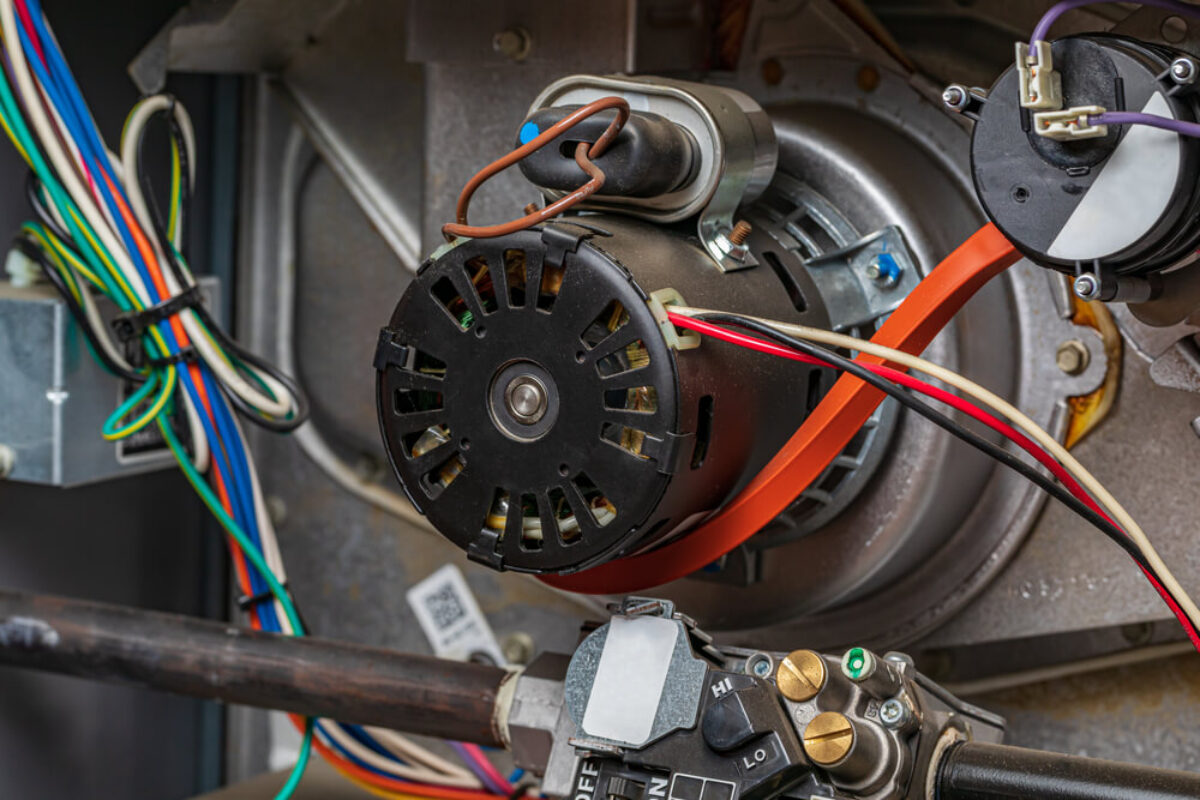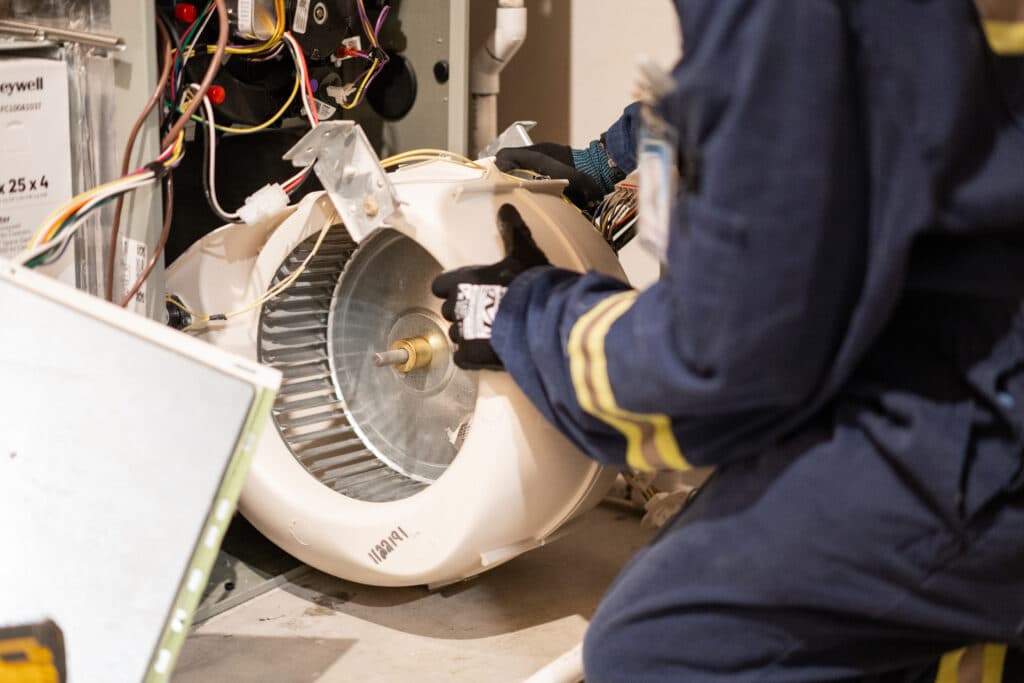Why is My Furnace Fan So Loud

If you’ve noticed that your furnace fan seems to be making more noise than usual, you’re not alone. A loud furnace fan can be annoying and disruptive and may indicate a more significant underlying issue. In this article, we’ll explore why furnace fans get noisy when you need to call in a professional and how to quiet things down.
What’s Causing the Noise?

There are a few key culprits that can cause a furnace fan to get louder over time:
Dust and Dirt Buildup
Like any household appliance, furnaces accumulate dust, dirt, and debris. This buildup on the fan blades can throw them out of balance, causing wobbling, vibration, and extra noise when the fan spins. Regular cleaning and maintenance, especially when furnace fan on or auto in winter, is crucial to preventing excessive dirt buildup that leads to a rattling, loud fan.
Worn Out Fan Bearings
The fan bearings allow the fan blades to spin smoothly. But over years of use, these bearings can wear out or get sticky, causing friction, resistance, and noisy operation as the fan struggles to turn. Replacing an aging, worn-out fan motor assembly often requires fixing a persistently noisy furnace fan due to bad bearings.
Bent, Unbalanced Fan Blades
If the fan blades have been bent out of shape or knocked off balance, this can also lead to an irritating rattling or loud humming noise as airflow passes over the disrupted blades. Carefully straightening or replacing bent fan blades may quiet things down.
Loose Parts
Loose screws, bolts, panels, connectors, and other fasteners can all cause annoying buzzing, rattling, and banging noises. Tightening loose parts inside the furnace cabinet can often eliminate these pesky noises.
Excessive Airflow Turbulence
The Ductwork leading to and from the furnace can also contribute to noise issues if the airflow becomes excessively turbulent. Restrictions, leaks, tight bends, and improper sizing or connections in the Ductwork can result in a roar or rumble as turbulent air flows through the vents.
Failing Fan Motor
If the fan motor itself is failing, this can cause loud squealing, grinding, or groaning noises when the fan tries to start up or spin. A furnace fan motor nearing the end of its lifespan may need professional replacement.
Loose Blower Wheel
The blower wheel that circulates air could be slightly loose on the motor shaft. This allows it to wobble around, causing loud rattling and shaking noises. Tightening the blower wheel or replacing the motor may be required.
As you can see, there are quite a few potential causes of a loud furnace fan, ranging from simple fixes to more involved repairs.
When to Call a Professional
While some noisy furnace fan issues you may be able to remedy yourself, it’s best to call in a professional furnace technician if:
- The noise started suddenly or is getting rapidly worse
- The noise happens when the fan first starts up or is especially loud when starting
- You notice grinding, squealing, or groaning noises
- The fan is visibly wobbling, shaking, or vibrating excessively
- The fan blades are cracked, bent, or visibly out of balance
- The noise varies in intensity or frequency as the fan speed changes
- The bearings seem seized up or very difficult to turn
- There are signs of leaking oil around the motor
- You smell electrical burning or smoke coming from the furnace
- There are any other signs of the fan failing or malfunctioning
These issues often indicate worn-out parts, motor failure, or deeper underlying problems requiring a professional diagnosis and repair. Prompt service can prevent costlier damage from occurring.
DIY Troubleshooting Steps

If the fan noise doesn’t seem severe, there are a few simple troubleshooting steps you can try yourself before calling in an HVAC technician:
1. Turn Off the Power and Inspect the Fan
Shut off power to the furnace at the breaker panel. Then, open the blower compartment to look at the fan blades and motor. Check for any debris buildup on the fan blades and clean if needed. Scrutinize the blades for cracks, dents, wobbling, or rubbing. Try rotating the fan by hand to feel for sticking or grinding.
2. Tighten Loose Parts
Use a screwdriver to firmly tighten any loose screws, bolts, or fasteners on the fan assembly, motor, cabinet panels, and duct connections. This may eliminate any rattling, vibration, or cabinet resonance.
3. Straighten Fan Blades
If the fan blades are bent, see if you can carefully straighten them using pliers. They should have uniform spacing all around and spin smoothly without wobbling.
4. Clean Fan Compartment
Use a vacuum and brush to thoroughly clean the entire fan compartment, removing all dirt, dust, lint, and debris. Pay attention to the fan blades, motor, and airflow paths.
5. Check Ductwork
Inspect all the Ductwork leading to and from the furnace for any blockages, crimping, or loose connections that could disrupt smooth airflow. Secure any loose fittings.
6. Lubricate Bearings
Place a few tiny drops of motor oil on the fan and motor bearings, being careful not to over-lubricate. Try rotating the fan again to see if this smoothes out any sticking or grinding issues.
7. Replace Filter
A dirty, clogged air filter makes the fan work harder and can cause noise. Swap in a new furnace filter if it’s been over three months.
If you’ve worked through these basic steps and the fan is still too loud for comfort, it’s time to call a professional for a proper diagnosis and repair.
When to Replace a Noisy Furnace Fan

If your furnace fan is making loud noises and you’ve ruled out simple fixes like cleaning and tightening, replacing the fan motor assembly may be required to solve the problem permanently.
Signs it’s time for a new furnace fan include:
- Visible cracks or damage to the fan blades
- Wobbling that won’t go away after rebalancing blades
- Grinding, squeaking, or rattling coming from the bearings
- The bearings are tough to turn by hand
- Fan blades that are loose on the shaft and can’t be tightened
- Electrical burning smells coming from the motor
Replacement furnace fan motors can range from $150 to $600 or more, depending on the motor type and furnace brand. A technician will need 1-2 hours to install the new motor and adequately calibrate the fan speeds.
While a bit spendy, replacing a defective fan motor is far less expensive than waiting until a bearing seizure or motor failure leaves you without heat on a cold day.
How to Quiet a Noisy Furnace Fan
Beyond essential maintenance, there are some other steps you can take to help muffle or minimize a loud furnace fan:
- Use rubber gaskets – Rubber gasket materials can help dampen vibration and noise when installed between the fan assembly and furnace cabinet.
- Tighten duct connections – Secure all Ductwork tightly to reduce airflow noise resonating through vents—seal leaks with mastic, foil tape, or caulk.
- Insulate Ductwork – Adding fiberglass insulation around exposed Ductwork dampens noise transmission through the metal duct walls.
- Install flex duct – Flexible insulated Ductwork attenuates and absorbs noise better than rigid metal ducts. Replace any noisy sheet metal duct sections with quieter flex ducts.
- Move fan motor – Relocating the fan motor away from cabinets and walls reduces resonance and noise amplification. Ask a technician about repositioning options.
- Buy a quieter replacement – When it’s time to replace the furnace fan, invest more upfront in an ultra-quiet variable speed or ECM fan motor for the longest-lasting noise reduction.
- Build a soundproof box – For severely noisy older furnace fans, you can build an insulated, sound-absorbing box around the fan housing. Line with insulation, seal all gaps and add rubber isolator mounts.
With strategic soundproofing upgrades like these, you can reduce the noise from a loud, aging furnace fan until you can budget for a total replacement. Any fix that reduces fan noise improves home comfort and provides healthier airflow.
Maintaining Your Furnace Fan

Carrying out regular furnace maintenance helps minimize noisy fan issues down the road. Be sure to:
- Replace filters every three months or as needed
- Have a technician inspect the furnace annually
- Listen for changes in fan noise over time
- Keep fan blades clean of debris
- Lubricate bearings yearly
- Check that all screws, bolts, and duct connections are tight
- Consider replacing fan motors after ten years or 100,000 hours of runtime
- Use quality replacement parts to maximize longevity
- Keep airflow unobstructed on the furnace intake and exhaust vents
- Replace any damaged or cracked fan blades immediately
Proper maintenance prevents costly repairs over time and keeps the furnace fan operating smoothly and quietly for many years.
When to Run the Furnace Fan
For the quietest operation, only run the furnace fan when necessary for heating or cooling:
- Run continuously during heating and cooling cycles to circulate air
- Turn off when the desired temperature is reached
- Only use “fan on” mode during moderate weather when air circulation is needed
Avoid running the fan continuously for long periods if unnecessary, as this accelerates wear on the motor. The exception is if continuous fan operation helps with humidity control or air filtration needs.
FAQs
How loud should a furnace fan be?
A properly operating furnace fan should produce a smooth “white noise” hum at around 50-70 decibels. Louder operation over 70dB indicates potential issues.
What causes a furnace fan motor to go wrong?
Age, dirt buildup, moisture damage, electrical issues, and general wear and tear can cause furnace fan motors to fail over 5-10 years. Signs of a failing motor include noisy operation, trouble starting up, and overheating.
Can I replace a furnace fan myself?
If you’re handy and have HVAC experience, you can replace the furnace fan motor. But it’s often best left to a professional due to gas lines and electrical and venting connections.
What should I do if the furnace fan is vibrating?
A vibrating furnace fan often indicates bent, unbalanced, or damaged fan blades. Try cleaning debris off blades, straightening if bent, or tightening mounting. If vibration persists, replacement may be required.
How much does it cost to replace a furnace fan motor?
The average cost to have a technician replace a furnace fan motor ranges from $250 – $600, including labor. Depending on motor type and brand, DIY replacement parts may run $100 – $300.
Conclusion
While a loud furnace fan can be irritating, identifying the cause is the first step toward remedying the problem. Issues like dirt buildup, worn-out bearings, and airflow obstructions often increase noise. If DIY troubleshooting doesn’t solve the issue, don’t hesitate to call in a professional for diagnosis and repair.




